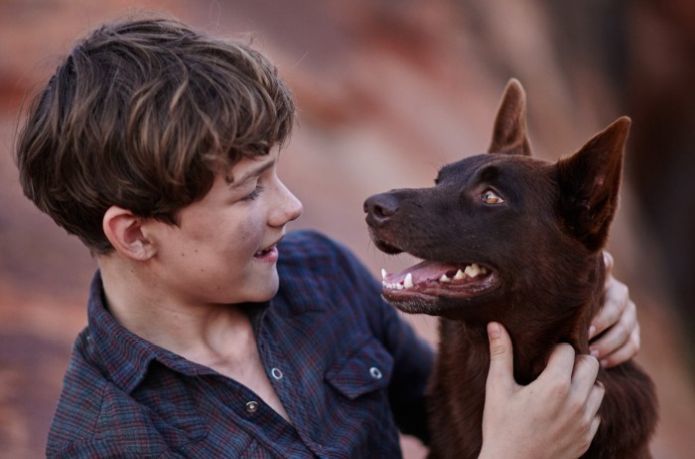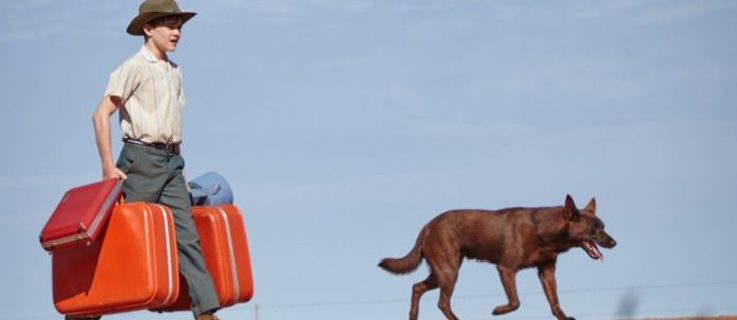What brings an Australian dog to Berlin? When the pooch in the spotlight is a rust-coloured kelpie known for his wandering ways, that’s a surprisingly easy question to answer. Red Dog leapt out of legend, beyond the pages of the book that told his tale, and into cinemas — starting at the 2011 Berlinale. It was simply another leg of his roaming journey, and while the canine’s real-life adventures might have stopped upon his passing in 1979, his story continues to take him far and wide. Six years after the first film enjoyed its world premiere in Germany, the sequel returns to unleash another account of Red Dog’s exploits. Talking Red Dog: True Blue with producer Nelson Woss.
In Red Dog: True Blue, which opened in Australia in December and screened at the Sundance Film Festival in January, the pooch no one can ever really call a pet is back. The repeat collaboration between director Kriv Stenders, writer Daniel Taplitz and producer Nelson Woss relates the antics of a young pup frolicking around a sprawling cattle property with an eleven-year-old, Mick (Levi Miller), desperately in need of a friend.
An Australian Love letter
For
Red Dog himself, it’s a fictional origin story. For those whose lives he touches, both on-screen and off, the film proves to be many things. Not only does it offer a heart-warming reminder of the bond between man and dog, but
Red Dog: True Blue also provides an exploration of identity, a family-friendly adventure, a love letter to the distinctive Australian landscape and spirit, and a chance to spend more time with an adored character.
“It's been a wonderful experience. I love how Australian audiences and just people have embraced the film,” says Woss. Revisiting
Red Dog “is like an opportunity,” he explains — and not just to see the canine in action in a younger form. Woss is passionate about the experience that the
Red Dog movies give audiences, as well as the emotional ride the features takes them on. ”It's almost like a nostalgic throwback film to have that experience, to get out, go on a date and experience something really moving in the cinema that is going to emotionally affect you, and to share that with people.”
 Red Dog: True Blue stars Levi Miller as Mick.
| © Good Dog Enterprises / David Darcy
Red Dog: True Blue stars Levi Miller as Mick.
| © Good Dog Enterprises / David Darcy
If there’s another thing that Woss is enthusiastic about, it’s telling Australian stories — and sharing them around the world. “People ask us ‘why did we make this second film?’ — it was simply because the director, Kriv Stenders, and myself have children,” he advises. “We think it is really important that Australian kids get to see their own culture on the big screen. And, to have the experience of seeing their own stories and celebrating what's really important and special about living in and being Australian.”
He continues, “We’re really confident in our film. You can go see it and enjoy it the same way that you can enjoy a film from anywhere in the world. The film is going to roam all over the world now. It is going to have a long festival life and get released all over the world - which is great because it is an Australian story that is able to travel. And when people understand different cultures, that can only be a good thing in terms of better relationships.”
Underneath the surface
Woss had a number of aims for
Red Dog: True Blue, some practical, some broader in remit. “One, we're Australian filmmakers, we just want to work again,” he laughs. “Two, Daniel Taplitz wanted to keep the screenplay fresh and original — but he wanted to have the heart and soul of the first movie. And, we wanted to be able to take this one further and for it be a standalone film.”
“We wanted to show something to our kids, and we wanted to go back to the region [the
Pilbara, where
Red Dog is set] because the region is known mainly for the mineral resources that are there and the mining. But, if you dig a little further under the surface, there is a rich resource of really amazing stories and legends and myths — some of which relate to
Red Dog, some of which just relate to the region. There’s an amazing Aborigine culture there. There are petroglyphs that we think are possibly some of the oldest in the world. I mean, you can see it in the film, you can point a camera anywhere, and it is beautiful — and we get very excited as filmmakers when there’s so much myth and legend around.”
With such a wealth of inspiration to draw upon, fans will be pleased to hear that there’s more to come in the
Red Dog story. “It was always envisioned to be a trilogy,” says Woss. “We didn't think that we were going to get the opportunity, but we felt that the
Red Dog legend has such a rich depth of material that we wanted to mine. And Daniel Taplitz always saw it as sort of three colours: the first one red, the second one blue, and we're not sure of the third one yet — it's either white or yellow.”
Red Dog: True Blue screens in Berlinale’s Generation Kplus program on February 10, 11, 12 and 16.

